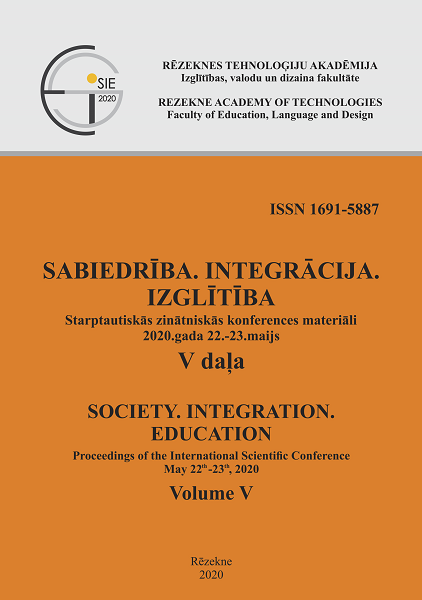CREATION AS A CONDITION FOR PERSONAL EXPRESSION AND INDIVIDUATION
DOI:
https://doi.org/10.17770/sie2020vol5.5017Keywords:
creation, creative motivation, creativity, individuationAbstract
The article discusses the basic concepts and theories of creation and creativity. Creativity is not applied to action, but is rather a psychological quality of a person that is manifested through certain abilities. The question is whether creativity is considered to be determined by spontaneous, irrational factors or can be promoted and is a stimulating phenomenon. The concept of Creativity, its features, as well as traits of a creative personality are distinguished. The following articles also discusses principles, prerequisites for creative motivation – when people become most creative. Creativity is universally considered to be a distinctive feature of a matured, multifaceted and self-realizing, and thus individualized personality. Creative abilities, as a transforming force, enhance a person’s sense of value, accelerate the individual’s self-fulfilment and maturation of personality.
References
Amabile, T. M. (1990). Within You, Without You: The Social Psychology of Creativity, and Beyond. In M. A. Runco & R. S. Albert (Eds.), Theories of creativity (61–91). Newbury Park, CA: Sage.
Amabile, T. M. (1993). Motivational Synergy: Toward New Conceptualizations of Intrinsic and Extrinsic Motivation in the Workplace. Human Resource Management Review 3(3), 185-201.
Amabile, T. M. (1996). Creativity in Context. Boulder, CO: Westview Press.
Amabile, T. M., Shatzel, E. A., Moneta, G. B., Kramer, S. J. (2004). Leader Behaviours and the Work Environment for Creativity: Perceived Leader Support. The Leadership Quarterly 17(1), 5-32. DOI: 10.1016/j.leaqua.2003.12.003
Bailin, S., Battersby, M. (2018). Inquiry: a New Paradigm for Critical Thinking. Ontario: University of Windsor.
Becker-Textor I. (2001). Kurybiskumas vaiku darzelyje: metodiniai nurodymai, kaip ugdyti vaiku intelekta vaiku darzelyje. Vilnius: Presvika.
Gardner, H. (1999). Intelligence Reframed: Multiple Intelligences for the 21st Century. NY: Basic Books.
Guilford, J. P. (1950). Creativity. American Psychologist, 5(9), 444–454. DOI: https://doi.org/10.1037/h0063487
Guilford, J. P. (1968). Intelligence, Creativity, and Their Educational Implications. San Diego, Cal.: Robert R. Knapp Publisher.
Hadamard, J. (1996). The Mathematician’s Mind. The Psychology of Invention in the Mathematical Field. New Jersey: Princeton University Press.
Hayes, J. R. (1989). Cognitive Processes in Creativity. In J. A. Glover, R. R. Ronning, C. R. Reynolds (Eds.), Perspectives on Individual Differences. Handbook of Creativity (135-145). NY: Plenum Press.
Kaufman, J. C., Sternberg, R. J. (2010). The Cambridge Handbook of Creativity. UK: Cambridge University Press.
Kilgour, M. (2006). Improving the Creative Process: Analysis of the Effects of Divergent Thinking Techniques and Domain Specific Knowledge on Creativity. International Journal of Business and Society, 7(2), 79-107.
Kogan, N. (1990). Creativity and Cognitive Style: A Life Span Perspective. In P. Baltes & K. W. Schaie (Eds.), Life Span Developmental Psychology: Personality and Socialization. NY: Academic Press.
Lukas, A. (1983). Kurybinis mastymas. Vilnius: Mintis.
MacKinnon, D. (1965). Personality and the Realization of Creative Potential. American Psychologist, 20(4), 273-281. DOI: 10.1037/h0022403
Maslow, A. H. (1959). New Knowledge in Human Values. NY: Harper.
Maslow, A. H. (1976). Creativity in Self-Actualizing People. In A. Rothenberg & C. R. Hausman (Eds.), The Creativity Question (86-92). Durham, NC: Duke University Press.
May, R. (1959). The Nature of Creativity. A Review of General Semantics, 16(3), 261-276.
McGuigan, J. (2016). Neoliberal Culture. UK: Palgrave Macmillan.
Mednick, M. T., Mednick, S. A., & Jung, C. C. (1964). Continual Association as a Function of Level of Creativity and Type of Verbal Stimulus. The Journal of Abnormal and Social Psychology, 69(5), 511–515. DOI: https://doi.org/10.1037/h0041086
Meusburger, P., Gluckler J., Meskioui, M. (2013) Knowledge and the Economy. Dordrecht: Springer.
Mirandola, G. et della (1984). Humanizmo idejos. In B. Genzelis (Ed.), Filosofijos istorijos chrestomatija. Renesansas (122-144). Vilnius: Mintis.
Mumford, M. D. (2003). Where Have We Been, Where Are We Going? Taking Stock in Creativity Research. Creativity Research Journal, 15(2-3), 107–120.
Rogers, R. S. (1959). The Emperor’s Displeasure-Amicitiam Renuntiare. Transactions and Proceedings of the American Philological Association, 90(1959), 224-237.
Rogers, C. R. (1959). A Tentative Scale for the Measurement of Process in Psychotherapy. In E. A. Rubinstein & M. B. Parloff (Eds.), Research in psychotherapy (96–107). American Psychological Association. DOI: https://doi.org/10.1037/10036-006
Rogers, C. R., Raskin, N. J. (2005). Person-Centred Therapy. In R. J. Corsini & D. Wedding (Eds.), Current Psychotherapies (130–165). UK: Thomson Brooks Cole.
Rothenberg A., Hausman, C. R. (1976). The Creativity Question. Durham, NC: Duke University Press.
Skinner, B. F. (1955). Freedom and the Control of Men. The American Scholar, 25(1), 47-65.
Sternberg R. J. (1988). A Three-Facet Model of Creativity. In R. J. Sternberg (Ed.), The Nature of Creativity: Contemporary Psychological Perspectives (125–147). UK: Cambridge University Press.
Sternberg, R. J., Neisser, U., Boodoo, G., Bouchard, T. J., et al. (1996). Intelligence: Knowns and Unknowns. American Psychologist, 51(2), 77–101. DOI: https://doi.org/10.1037/0003-066X.51.2.77
Sternberg R. J. (1999). Handbook of Creativity. UK: Cambridge University Press.
Sternberg, R. J., Jarvin L., Grigorenko E. (2009). Teaching for Wisdom, Intelligence, Creativity, and Success. NY: Skyhorse Publishing.
Sternberg R. J. (2009). The Rainbow and Kaleidoscope Projects: A New Psychological Approach to Undergraduate Admissions. European Psychologist, 14(4), 279-287. DOI: 10.1027/1016-9040.14.4.279
Tatarkiewicz, W. (2018). Apie Laime. Vilnius: Mokslo ir enciklopedijų leidybos centras.
Torrance, E. P. (1987). Research on Creativity Assessment. In S.G. Isaksen (Ed.), Frontiers of Creativity Research (103-109). Buffalo, NY: Bearly.
Torrance, E. P. (1974). The Torrance Tests of Creative Thinking: Norms-Technical Manual. Princeton, NJ: Personal Press.
Urban, K. K. (1990). Recent Trends in Creativity Research and Theory in Western Europe, European Journal of High Ability, 1(1), 99-113. DOI: https://doi.org/10.1080/0937445900010114
Watson J. B. (1913). Classics in the History of Psychology: Psychology as the Behaviorist Views it. Psychological Review, 20, 158-177.
Weisberg, R. W. (1993). Creativity: Beyond the Myth of Genius. NY: W.H. Freeman & Company.






